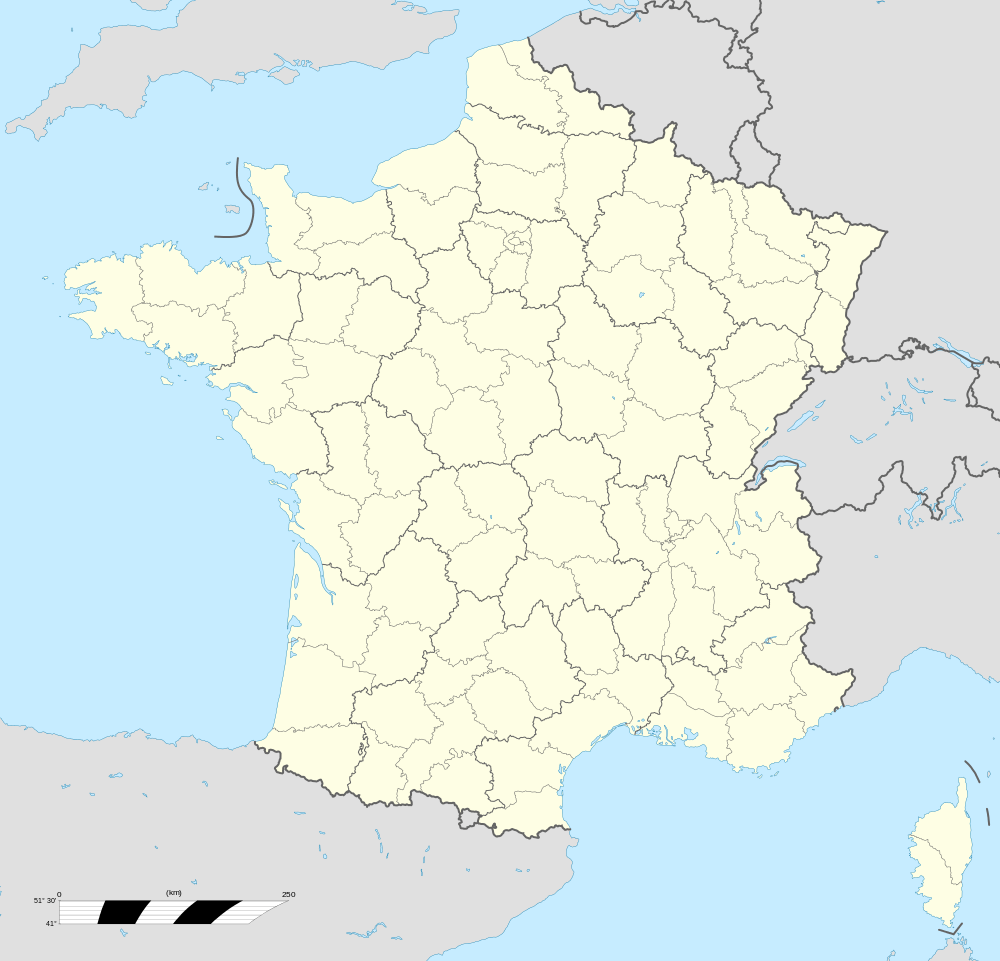Sélestat
| Sélestat | |
|---|---|
|
Saint-Georges Church | |
 Sélestat | |
|
Location within Alsace region  Sélestat | |
| Coordinates: 48°16′N 7°28′E / 48.26°N 7.46°ECoordinates: 48°16′N 7°28′E / 48.26°N 7.46°E | |
| Country | France |
| Region | Alsace |
| Department | Bas-Rhin |
| Arrondissement | Sélestat-Erstein |
| Canton | Sélestat |
| Intercommunality | Communauté de communes de Sélestat et environs |
| Government | |
| • Mayor (2008–2014) | Marcel Bauer |
| Area1 | 44.40 km2 (17.14 sq mi) |
| Population (2006)2 | 19,459 |
| • Density | 440/km2 (1,100/sq mi) |
| INSEE/Postal code | 67462 / 67600 |
| Elevation |
165–184 m (541–604 ft) (avg. 173 m or 568 ft) |
|
1 French Land Register data, which excludes lakes, ponds, glaciers > 1 km² (0.386 sq mi or 247 acres) and river estuaries. 2 Population without double counting: residents of multiple communes (e.g., students and military personnel) only counted once. | |
Sélestat (French: Sélestat, pronounced: [selɛsta]; Alsatian: Schlestatt or Schlettstadt, [ˈʃlɛd̥ʃd̥ɐd̥]; (German: ![]() Schlettstadt )) is a commune in the Bas-Rhin department in Alsace in north-eastern France.
Schlettstadt )) is a commune in the Bas-Rhin department in Alsace in north-eastern France.
In 2006, Sélestat had a total population of 19,459.[1] The Communauté de communes de Sélestat et environs had a total population of 35,397.[2]
Geography
Sélestat is located in central Alsace, 22 km (14 mi) north of Colmar and 47 km (29 mi) south of Strasbourg, on the left bank of the Ill River.
Sélestat is near the Alsace wine route, and other notable sites such as the Château du Haut-Kœnigsbourg.
Sights and culture
The city is one of the richest and most varied in terms of architecture among the smaller cities of Alsace. Most remarkable are the Romanesque St. Faith's Church and the Gothic St. George's Church, the Baroque clock tower (1618) and the neo-medieval water tower. Buildings like the town hall (1788), the railway station (1880s) and the synagogue (1890s), as well as several Renaissance and Baroque civil houses are similarly noteworthy.
The Humanist Library displays one of the oldest and most homogeneous collections of medieval manuscripts and Renaissance books in Europe. Its core is the still almost intact library of Beatus Rhenanus, that had been bequeathed to the city and kept by it ever since.
Sélestat is the cultural center of central Alsace and is the seat of the Fonds régional d'art contemporain Alsace (FRAC Alsace)[3] (contemporary art in and of Alsace) and of the Pôle d'archéologie interdépartemental rhénan (PAIR)[4] (archaeology of and in Alsace).
History
Sélestat is a place of very early origin. It was a royal residence in Carolingian times and became a free town of the Holy Roman Empire in the 13th century. In the 15th century it was the seat of a celebrated academy, founded by the humanist Rodolphus Agricola, which contributed not a little to the revival of learning in this part of Germany; Erasmus of Rotterdam was one of its students.[5]
In 1634 the town came into the possession of France, and it was afterwards fortified by Vauban. It offered little resistance, however, to the Germans in 1870, and the fortifications have since been razed.[5]
Just to the west of Sélestat stands the great castle of Haut-Kœnigsbourg, at an elevation of 2,475 feet (754 m). It was presented to the German Emperor William II by the town of Sélestat in 1899, and was completely restored in 1908. The site is first mentioned as bearing a castle in the 8th century.[5]
Sélestat AM transmitter
South of Sélestat, at 48°15′4″N 7°25′28″E / 48.25111°N 7.42444°E, is a large broadcasting facility used for transmitting on 1161 kHz and 1278 kHz in the mediumwave range.
The facility consists of two directional antenna systems, each for one frequency. Each of the system consists of three guyed base-fed mast radiators insulated against ground, about 60 m high, which are arranged on a line with a little bow to deserve precisely the Alsatian Plain.
Notable people
- Martin Bucer
- Eugène Koeberlé
- Heinrich Kramer
- Johannes Mentelin
- Beatus Rhenanus
- François Ignace Schaal
- Jakob Wimpfeling
Twin towns
-
.svg.png) Charleroi, Belgium, since 1959
Charleroi, Belgium, since 1959 -
 Dornbirn, Austria, since 2006
Dornbirn, Austria, since 2006 -
 Grenchen, Switzerland, since 1988
Grenchen, Switzerland, since 1988 -
 Waldkirch, Germany, since 1966
Waldkirch, Germany, since 1966
See also
Notes
- ↑ Commune : Sélestat (67462) on INSEE
- ↑ EPCI à fiscalité propre : CC de Sélestat et Environs (246700967) on INSEE
- ↑ FRAC Alsace, artenalsace.org (French)
- ↑ www.pair-archeologie.fr (French)
- ↑ 5.0 5.1 5.2 Chisholm 1911, p. 340.
References
- Attribution
-
 This article incorporates text from a publication now in the public domain: Chisholm, Hugh, ed. (1911). "Schlettstadt". Encyclopædia Britannica 24 (11th ed.). Cambridge University Press. p. 340.
This article incorporates text from a publication now in the public domain: Chisholm, Hugh, ed. (1911). "Schlettstadt". Encyclopædia Britannica 24 (11th ed.). Cambridge University Press. p. 340.
External links
| Wikimedia Commons has media related to Sélestat. |
- City council website (French)
- Office de Tourisme website (French)
- Sélestat: images (German)
